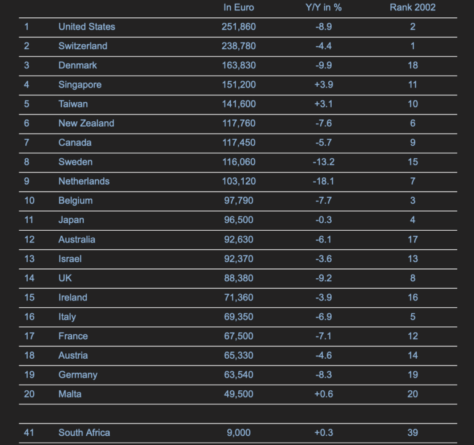Allianz Global Wealth Report 2023: South Africa’s financial assets continue to grow
Allianz, which provides commercial insurance in South Africa, unveiled the 14th edition of its “Global Wealth Report”, which puts the asset and debt situation of households in almost 60 countries under the microscope.
Annus horribilis
2022 was an annus horribilis for savers. Asset prices fell across the board in the “everything slump” scenario. The result was a dismal -2.7% decline in private households’ global financial assets[1], the strongest drop since the Global Financial Crisis (GFC) in 2008. Growth rates of the three major asset classes, however, differed markedly. While securities (-7.3%) and insurance/pensions (-4.6%) saw strong setbacks, bank deposits showed robust growth at +6.0%. Overall, financial assets worth EUR 6.6 trillion were lost, total financial assets amounted to EUR 233 trillion at the end of 2022. The decline was most pronounced in North America (-6.2%), followed by Western Europe (-4.8%). Asia, on the other hand – with the exception of Japan – still recorded relatively strong growth rates. China’s financial assets grew robustly, too, clocking growth of 6.9%. But compared to the previous year (+13.3%) and the long-term average of the last 20 years (+15.9%), this was a rather disappointing development – repeated lockdowns clearly took their toll.
South Africa: modest growth
The gross financial assets of South African households increased by a modest 1.7% in 2022, way below the increase in the previous year (15.1%). The slowdown was across the board: the asset class insurance/pension – with a portfolio share of 55% the dominant asset class in South Africa – grew by meagre 2.1% (2021: 14.2%), bank deposits slowed to 6.6% (8.6%) and securities even lost in value (-0.9% in 2022 against +20.1% in 2021).
Compared to the pre-pandemic year of 2019, financial assets are 22.3% higher – but only in nominal terms. Adjusted for inflation, the increase is reduced to a much more modest 5.9% in three years. Growth in liabilities accelerated to 7.3% in 2022, after 5.8% in 2021. As a result, the debt-to-GDP ratio remained flat at 41%, some 9pp below its peak in 2007. Net financial assets, finally, remained basically flat (+0.3%). With net financial assets per capita of EUR 9,000, South Africa climbed one rung to 41st position in the ranking of the richest countries.
Wiped out
Despite bitter losses, global household financial assets were still nearly 19% above pre-Covid-19 levels at the end of last year – in nominal terms. Adjusted for inflation, almost two-thirds of (nominal) growth fell victim to price increases, reducing real growth to a meagre 6.6% in three years. While most regions could at least preserve some real growth in wealth, the situation in Western Europe is different: Any nominal gains were wiped out, real wealth decreased by -2.6% over 2019.
“For years, savers complained about zero interest rates.”, said Ludovic Subran, chief economist of Allianz. “But the real enemy of savers is inflation. And not only since the inflation surge after Covid-19. In South Africa, for example, assets per capita increased sixfold before inflation over the last 20 years. But after inflation, the increase is a less impressive 80%. This underlines the need for smart saving and increased financial literacy. But inflation is a hard beast to beat. Without some nudges and professional advice for long-term savings most savers might struggle.”
No tailwinds
After the decline in 2022, global financial assets should return to growth in 2023. This is supported above all by the (so far) positive development on the stock markets. All in all, we expect global financial assets to increase by around 6%, also taking into account a further “normalization” of savings behavior. Given a global inflation rate of around 6% in 2023, savers should be spared another year of real losses on their financial assets.
“The mid-term outlook, however, is rather mixed.”, said Patricia Pelayo Romero, co-author of the report. “There will be no monetary or economic tailwinds to blow. Average growth of financial assets is likely to hover between 4% and 5% over the next three years, under the assumption of average stock markets returns. But like the weather, which gets more extreme amid climate change, more market swings are to be expected in the new geopolitical and economic landscape. ‘Normal’ years might rather become the exception.”
Belt tigthening
The interest rate turnaround was also clearly felt on the liabilities side of the private household balance sheet. After global private debt had risen by 7.8% in 2021, growth weakened significantly last year to 5.7%. The sharpest fall was seen in China: last year’s debt growth of +5.4% was the lowest growth on record. Overall, global household liabilities totaled EUR 55.8trn at the end of 2022. As the gap between debt and economic growth widened to 3.9pp, the global debt-to-GDP ratio (liabilities as a percentage of GDP) has fallen significantly by more than 2pp to 66.1% in 2022. This means that the global debt ratio for private households is back at about the same level as it was at the beginning of the millennium – a remarkable level of stability that hardly fits the widespread narrative of a world drowning in debt. However, there have been major shifts in the world debt map. First and foremost, stability characterizes the development in advanced economies. On the other hand, most emerging markets have seen their debt ratios rise sharply over the last two decades. China is at the top of the list, with a ratio that has more than tripled to a good 61%.
Net financial assets per capita in 2022





